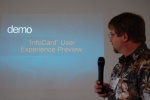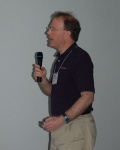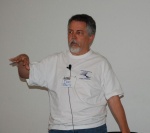Everyone in attendance was awe-struck by the IIW 2006 that just took place in Mountainview. It was incredible.
With Doc Searls and Phil Windely navigating at the macro-level, the amazing Identity Woman Kaliya orchestrated an “unconference” that was one of the most effective events I've ever attended. It's clear that creating synergy out of chaos is an art that these three have mastered, and participants floated in and out of sessions that self-organized around an ongoing three-day hallway conversation – the hallway actually being the main conference room and event! So we got to engage in all kinds of one-on-one (and few) conversations, meet new people, work out concerns and above all work on convergence. Many people told me they felt history was being made, and I did too.
People showed amazing new demos of identity metasystem software from many different approaches and on many platforms. People, we are achieving orbit.
Here is some of Phil Windely's report on day one, a kind of level-set for newcomers. I'll link to more reports when I get home.
We moved upstairs to accommodate the crowd and ended up with a lot more elbow room. Dick Hardt was the first speaker after the break. he gave a new version of his famous Identity 2.0 talk.
Dick mentions BCeID, a government identity service that forms a basis for digital identity in BC. I’ve long argued that governments have abdicated the responsibility for provide commerce supporting infrastructure online. (By “infrastructure†I mean legal frameworks more than hardware and software.) BCeID looks to be mostly about government online services, but Dick points out that he’s interested in seeing how it can be used by other places, like BC Hydro (power company).
Dick quotes Larry Wall’s dictum about Perl, “Easy things are easy and hard things are possible,†as a good basis for evaluating identity schemes. He lists a number of ideas that fall into the “hard things†category: agency, compartmentalization, notification, and granularity.
|
Mike Jones and the demo
(click to enlarge)
|
Mike Jones from Microsoft was given the task of introducing the Laws of Identity and InfoCard. As a way of introducing InfoCard, Mike talks about claims and credentials in the physical world and how we use them. Mike spent a good deal of time talking about the laws. I think that was time well spent—they form a good basis for many of the conversations we want to have at IIW.
The identity metasystem concept is aimed at not inventing a new identity system, but inventing a system that can unify different identity systems. InfoCard confuses people because it seems like an identity system and has to be, in some sense, but it’s open because of the standards involved, so other identity systems can be adapted to work with it. The fact that there will be at least one open source and one commercial InfoCard system up before Microsoft releases it is testament to this.
InfoCard is an attempt to provide a simple user abstraction for digital identities that’s grounded in a physical world metaphor of credentials. The success of InfoCard is dependent on others implementing InfoCard.
Eve Maler from Sun was charged with discussing the Liberty Alliance Project. She quotes H.H. Monroe as “a little inaccuracy sometimes saves lots of explanation†by way of saying that in 20 minutes, she’s going to have to wave her hands a bit to get it all in.
About half the audience was familiar with SAML. Eve went through some high-level use cases as a way of introducing concepts and then moved into SAML and Liberty specific use cases.
|
DSC_0002.JPG
(click to enlarge)
|
Drummond Reed spoke about XRIs. XRIs are a way of using a URL-like syntax, that is backwards compatible with the Web, to represent identifier authorities. On the IRC backchannel (#identity on freenode.net), someone said “isn’t an email address a URI?†when Johannes was talking and URL-based identity. XRI, as a Yadis compatible identity syntax, makes it clear that email addresses are part of URI-based identity.
So why a new addressing scheme? There are many different devices and different addressing schemes for each one. Even though each (like phone numbers and email) are controlled by a single entity, they each have a different syntax and controlling authority. A unified identifier can make managing these various addresses more convenient and add new services.
Drummond yielded some of his time to Andy Dale to speak a little about XDI. I wrote extensively about this last December when I was at the XDI workshop that Andy put on.
|
DSC_0004.JPG
(click to enlarge)
|
Doc Searls got here right before the break and I asked him to redo his talk to set some things up for tomorrow. Doc brings up the Cluetrain Manifesto and how he realized over time that identity was critical to that vision. He recounts the history of “how we got here†(see Kaliya’s Map).
Moving from history, Doc starts talking about attention, intention, and marketplaces. These all get down to relationships. Doc has blogged about this at the IT Garage under the banner Starring in Your Own Constellation: Independent Identity in Networked Markets.
My Internet Identity Workshop pictures are up.

 In the seemingly never-ending war against spyware and other intrusive and harmful software, the Federal Trade Commission has struck a blow against Sanford Wallace, known as the “Spam King,” for his habit of sending mass e-mails. A judge in the District Court of New Hampshire has
In the seemingly never-ending war against spyware and other intrusive and harmful software, the Federal Trade Commission has struck a blow against Sanford Wallace, known as the “Spam King,” for his habit of sending mass e-mails. A judge in the District Court of New Hampshire has 


 Despite being reconciled to many annoying things, I still harbor palpable resentment against the abominable GE “puffer” machine in which
Despite being reconciled to many annoying things, I still harbor palpable resentment against the abominable GE “puffer” machine in which